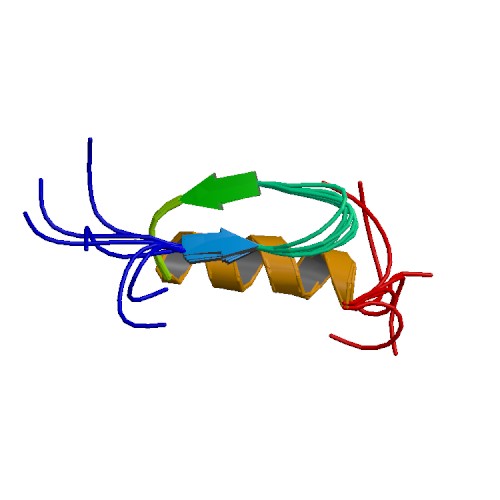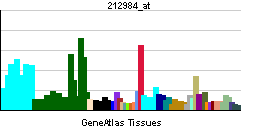Activating transcription factor 2: Difference between revisions
m (Bot: Automated text replacement (-{{SIB}} + & -{{EH}} + & -{{EJ}} + & -{{Editor Help}} + & -{{Editor Join}} +)) |
(No difference)
|
Revision as of 20:40, 8 August 2012
| Activating transcription factor 2 | |||||||||||
|---|---|---|---|---|---|---|---|---|---|---|---|
 PDB rendering based on 1bhi. | |||||||||||
| Identifiers | |||||||||||
| Symbols | ATF2 ; CREB2; CRE-BP1; HB16; MGC111558; TREB7 | ||||||||||
| External IDs | Template:OMIM5 Template:MGI HomoloGene: 31061 | ||||||||||
| |||||||||||
| RNA expression pattern | |||||||||||
 | |||||||||||
 | |||||||||||
| More reference expression data | |||||||||||
| Orthologs | |||||||||||
| Template:GNF Ortholog box | |||||||||||
| Species | Human | Mouse | |||||||||
| Entrez | n/a | n/a | |||||||||
| Ensembl | n/a | n/a | |||||||||
| UniProt | n/a | n/a | |||||||||
| RefSeq (mRNA) | n/a | n/a | |||||||||
| RefSeq (protein) | n/a | n/a | |||||||||
| Location (UCSC) | n/a | n/a | |||||||||
| PubMed search | n/a | n/a | |||||||||
Overview
Activating transcription factor 2, also known as ATF2, is a human gene.[1]
This gene encodes a transcription factor that is a member of the leucine zipper family of DNA binding proteins. This protein binds to the cAMP-responsive element (CRE), an octameric palindrome. The protein forms a homodimer or heterodimer with c-Jun and stimulates CRE-dependent transcription. The protein is also a histone acetyltransferase (HAT) that specifically acetylates histones H2B and H4 in vitro; thus it may represent a class of sequence-specific factors that activate transcription by direct effects on chromatin components. Additional transcript variants have been identified but their biological validity has not been determined.[1]
The gene atf2 is located at human chromosome 2q32[2]. The protein ATF-2 has 505 amino acids. Studies in mice indicate a role for ATF-2 in the development of nervous system and the skeleton[3]. ATF-2 is normaly activated in response to signals that converge on stress-activated protein kinases p38 and JNK[4]. Several studies implicate abnormal activation of ATF-2 in growth and progression of mammalian skin tumors[5][6]. ATF-2 may mediate oncogenesis caused by mutant Ras protein[7] and regulate maintenance of the aggressive cancer phenotype of some types of epithelial cells.
See also
References
- ↑ 1.0 1.1 "Entrez Gene: ATF2 activating transcription factor 2".
- ↑ Ozawa K, Sudo T, Soeda E, Yoshida MC, Ishii S (1991). "Assignment of the human CREB2 (CRE-BP1) gene to 2q32". Genomics. 10 (4): 1103–4. PMID 1833307.
- ↑ Reimold AM, Grusby MJ, Kosaras B; et al. (1996). "Chondrodysplasia and neurological abnormalities in ATF-2-deficient mice". Nature. 379 (6562): 262–5. doi:10.1038/379262a0. PMID 8538792.
- ↑ Gupta S, Campbell D, Dérijard B, Davis RJ (1995). "Transcription factor ATF2 regulation by the JNK signal transduction pathway". Science. 267 (5196): 389–93. doi:0.1126/science.7824938 Check
|doi=value (help). PMID 7824938. - ↑ Leslie MC, Bar-Eli M (2005). "Regulation of gene expression in melanoma: new approaches for treatment". J. Cell. Biochem. 94 (1): 25–38. doi:10.1002/jcb.20296. PMID 15523674.
- ↑ Papassava P, Gorgoulis VG, Papaevangeliou D, Vlahopoulos S, van Dam H, Zoumpourlis V (2004). "Overexpression of activating transcription factor-2 is required for tumor growth and progression in mouse skin tumors". Cancer Res. 64 (23): 8573–84. doi:10.1158/0008-5472.CAN-03-0955. PMID 15574764.
- ↑ Vlahopoulos SA, Logotheti S, Mikas D, Giarika A, Gorgoulis V, Zoumpourlis V (2008 March 17). "The role of ATF-2 in oncogenesis". Bioessays. 30 (4): 314–327. doi:10.1002/bies.20734. PMID 18348191. Check date values in:
|date=(help)
Further reading
- Denys H, Desmet R, Stragier M; et al. (1978). "Cystitis emphysematosa". Acta urologica Belgica. 45 (4): 327–31. PMID 602896.
- Kim SJ, Wagner S, Liu F; et al. (1992). "Retinoblastoma gene product activates expression of the human TGF-beta 2 gene through transcription factor ATF-2". Nature. 358 (6384): 331–4. doi:10.1038/358331a0. PMID 1641004.
- Hai T, Curran T (1991). "Cross-family dimerization of transcription factors Fos/Jun and ATF/CREB alters DNA binding specificity". Proc. Natl. Acad. Sci. U.S.A. 88 (9): 3720–4. PMID 1827203.
- Hoeffler JP, Lustbader JW, Chen CY (1991). "Identification of multiple nuclear factors that interact with cyclic adenosine 3',5'-monophosphate response element-binding protein and activating transcription factor-2 by protein-protein interactions". Mol. Endocrinol. 5 (2): 256–66. PMID 1828107.
- Ozawa K, Sudo T, Soeda E; et al. (1991). "Assignment of the human CREB2 (CRE-BP1) gene to 2q32". Genomics. 10 (4): 1103–4. PMID 1833307.
- Diep A, Li C, Klisak I; et al. (1992). "Assignment of the gene for cyclic AMP-response element binding protein 2 (CREB2) to human chromosome 2q24.1-q32". Genomics. 11 (4): 1161–3. PMID 1838349.
- Kara CJ, Liou HC, Ivashkiv LB, Glimcher LH (1990). "A cDNA for a human cyclic AMP response element-binding protein which is distinct from CREB and expressed preferentially in brain". Mol. Cell. Biol. 10 (4): 1347–57. PMID 2320002.
- Gonzalez GA, Yamamoto KK, Fischer WH; et al. (1989). "A cluster of phosphorylation sites on the cyclic AMP-regulated nuclear factor CREB predicted by its sequence". Nature. 337 (6209): 749–52. doi:10.1038/337749a0. PMID 2521922.
- Maekawa T, Sakura H, Kanei-Ishii C; et al. (1989). "Leucine zipper structure of the protein CRE-BP1 binding to the cyclic AMP response element in brain". EMBO J. 8 (7): 2023–8. PMID 2529117.
- Raingeaud J, Gupta S, Rogers JS; et al. (1995). "Pro-inflammatory cytokines and environmental stress cause p38 mitogen-activated protein kinase activation by dual phosphorylation on tyrosine and threonine". J. Biol. Chem. 270 (13): 7420–6. PMID 7535770.
- Livingstone C, Patel G, Jones N (1995). "ATF-2 contains a phosphorylation-dependent transcriptional activation domain". EMBO J. 14 (8): 1785–97. PMID 7737129.
- van Dam H, Wilhelm D, Herr I; et al. (1995). "ATF-2 is preferentially activated by stress-activated protein kinases to mediate c-jun induction in response to genotoxic agents". EMBO J. 14 (8): 1798–811. PMID 7737130.
- Zhou Q, Gedrich RW, Engel DA (1995). "Transcriptional repression of the c-fos gene by YY1 is mediated by a direct interaction with ATF/CREB". J. Virol. 69 (7): 4323–30. PMID 7769693.
- Newell CL, Deisseroth AB, Lopez-Berestein G (1994). "Interaction of nuclear proteins with an AP-1/CRE-like promoter sequence in the human TNF-alpha gene". J. Leukoc. Biol. 56 (1): 27–35. PMID 8027667.
- Nomura N, Zu YL, Maekawa T; et al. (1993). "Isolation and characterization of a novel member of the gene family encoding the cAMP response element-binding protein CRE-BP1". J. Biol. Chem. 268 (6): 4259–66. PMID 8440710.
- Martin ML, Lieberman PM, Curran T (1996). "Fos-Jun dimerization promotes interaction of the basic region with TFIIE-34 and TFIIF". Mol. Cell. Biol. 16 (5): 2110–8. PMID 8628277.
- Yang L, Lanier ER, Kraig E (1997). "Identification of a novel, spliced variant of CREB that is preferentially expressed in the thymus". J. Immunol. 158 (6): 2522–5. PMID 9058782.
- Shuman JD, Cheong J, Coligan JE (1997). "ATF-2 and C/EBPalpha can form a heterodimeric DNA binding complex in vitro. Functional implications for transcriptional regulation". J. Biol. Chem. 272 (19): 12793–800. PMID 9139739.
- Fukunaga R, Hunter T (1997). "MNK1, a new MAP kinase-activated protein kinase, isolated by a novel expression screening method for identifying protein kinase substrates". EMBO J. 16 (8): 1921–33. doi:10.1093/emboj/16.8.1921. PMID 9155018.
- Kumar S, McDonnell PC, Gum RJ; et al. (1997). "Novel homologues of CSBP/p38 MAP kinase: activation, substrate specificity and sensitivity to inhibition by pyridinyl imidazoles". Biochem. Biophys. Res. Commun. 235 (3): 533–8. doi:10.1006/bbrc.1997.6849. PMID 9207191.